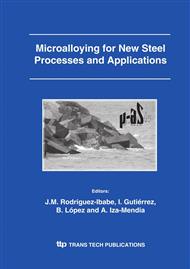p.131
p.139
p.147
p.155
p.163
p.171
p.179
p.187
p.195
Continuous Casting of Microalloyed Steels. Influence of Composition and Operational Parameters in Billet Surface Cracking
Abstract:
Surface defects, mainly intergranular cracks (IGC), in as cast billet is the main concern for the production of microalloyed steels with the continuous casting process. A description is given of the IGC in the as cast billet surface and the main casting parameters influencing its formation. An analytical model of the influence of the microalloyed content in the formation of precipitates and the corresponding billet surface ductility at the temperature of billet straightening is presented. The model was validated with bibliographical ductility experimental values and was used to perform composition optimisation for continuous casting production. The analytical approach has been completed with a numerical precipitation model coupled with a continuous casting billet solidification model. The coupled program allows precipitate size distribution calculation in selected points of the cross billet section as a function of production parameters, steel composition and billet size. These precipitate distributions are important to detect ductility problems in billets and to optimise the operational parameters so as to avoid these problems.
Info:
Periodical:
Pages:
163-170
Citation:
Online since:
November 2005
Authors:
Price:
Сopyright:
© 2005 Trans Tech Publications Ltd. All Rights Reserved
Share:
Citation:


